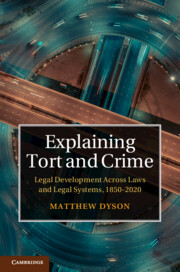Book contents
- Explaining Tort and Crime
- Explaining Tort and Crime
- Copyright page
- Contents
- Foreword
- Preface
- Table of Cases
- Table of Legislation
- Part I Setting the Scene: Introduction and Methods for Explaining
- Part II Mental States and Careless Acts: The Development of Fault Doctrine in Crime and Tort
- Part III Procedures Interfacing Tort and Crime
- 6 Claims and Formats
- 7 Timing Rules
- 8 Criminal Judgments in the Civil Law
- Part IV Conclusions
- Index
7 - Timing Rules
from Part III - Procedures Interfacing Tort and Crime
Published online by Cambridge University Press: 07 July 2022
- Explaining Tort and Crime
- Explaining Tort and Crime
- Copyright page
- Contents
- Foreword
- Preface
- Table of Cases
- Table of Legislation
- Part I Setting the Scene: Introduction and Methods for Explaining
- Part II Mental States and Careless Acts: The Development of Fault Doctrine in Crime and Tort
- Part III Procedures Interfacing Tort and Crime
- 6 Claims and Formats
- 7 Timing Rules
- 8 Criminal Judgments in the Civil Law
- Part IV Conclusions
- Index
Summary
For over 400 years English civil courts have accepted some form of chronological pre-eminence of the criminal law where civil and serious criminal liability exist for the same facts.1 The victim of a crime would have to wait to bring a claim for compensation, or any other civil remedy such as an injunction. One of the underlying tensions is that that criminal process has often made those remedies harder to satisfy by depleting the defendant’s resources.
- Type
- Chapter
- Information
- Explaining Tort and CrimeLegal Development Across Laws and Legal Systems, 1850–2020, pp. 362 - 404Publisher: Cambridge University PressPrint publication year: 2022

